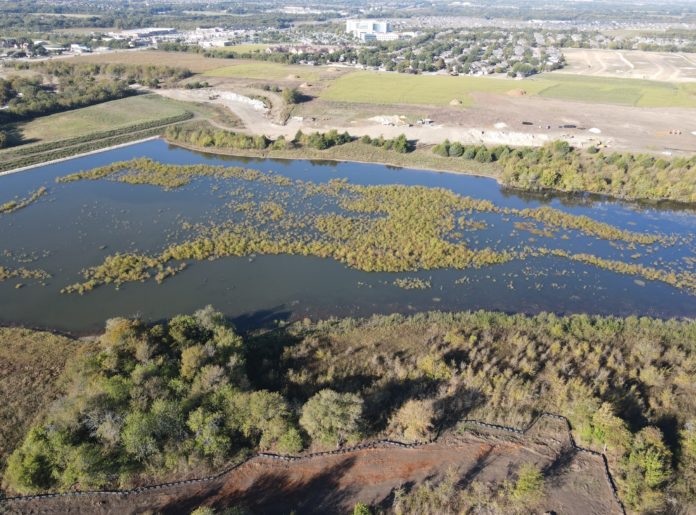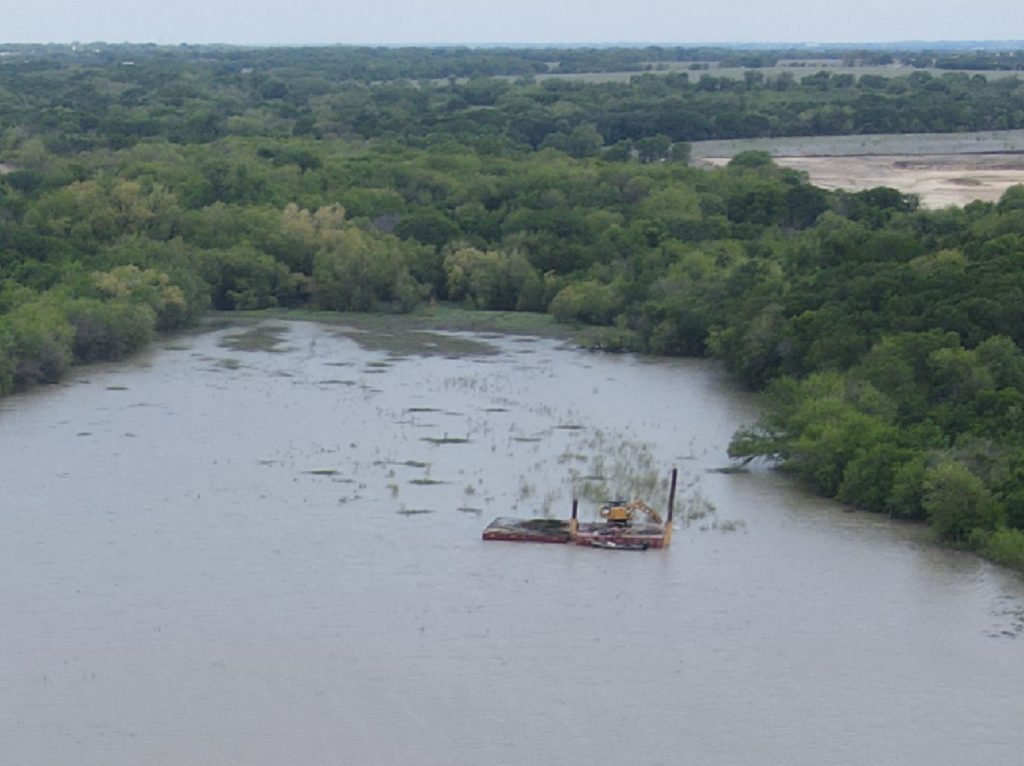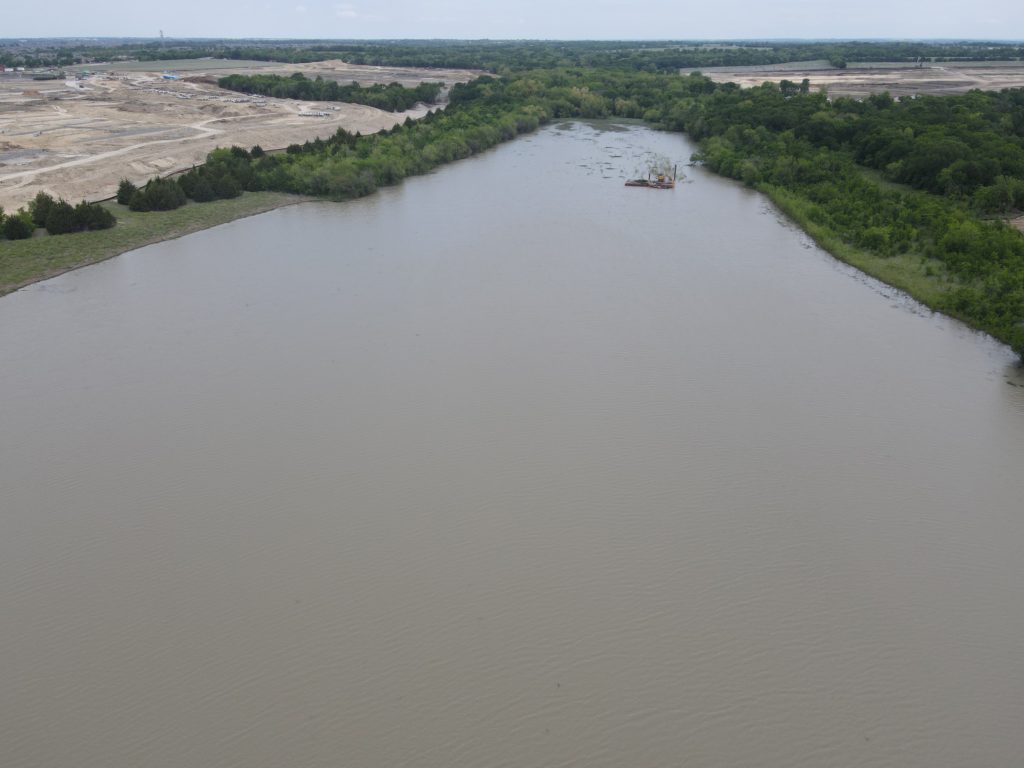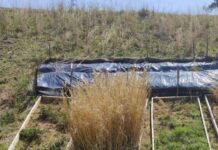
A connection to nature is a key marketing strategy for the developers of Painted Tree, a 1,000-acre master-planned community in McKinney, Texas. With 69% of potential homebuyers in the Dallas-Fort Worth metroplex ranking walking trails as the most desired community amenity and 63% of potential homebuyers rating lake, pond and water features highly1, the property’s existing lake provided the perfect centerpiece for the property’s recreation and walking trail plans.
The 20-acre lake, however, required care before it could become the water feature that tied the community’s nature-focused plans together.
The land had not been used for a number of years before the developer bought it, so there was no maintenance of the lake, dam and surrounding land. There was a lot of vegetation as well as willow trees in the middle of the lake, and it was only 5 to 10 feet deep in some spots (Figure 1).
The first step was to remove vegetation to restore the lake to what it had been. Care had to be taken around the dam, but most of the vegetation was in the middle of the lake, so the risk to the dam was minimal. An excavator bucket with a thumb on a barge was used to reach the areas in which the vegetation was located (Figure 2). Material barges and boats were used to transport the material to the bank for landscapers to mulch and recycle throughout the development. Because there were no dredge spoils, just trees, there was no need for any erosion control BMPs.
The project was completed in 30 days, with crews working 12 hours per day, seven days a week.

Dredging to Increase Depth of Lakes or Waterways
While there was no removal of sediment to further deepen the lake at Painted Tree, it is a process that can be used to restore lakes in addition to the removal of vegetation.
One of the concerns about the dredging process is unwanted turbidity, or the generation of fine sediment that will travel downstream or collect on the banks of a lake. Capturing the silt and sand to control it can be accomplished in several ways, similar to the use of silt fence on land. On the Painted Tree project, turbidity curtains were used around the dredge area and the dam outfall to prevent sediment from moving downstream.
Also known as floating silt fences, turbidity curtains are assembled on shore and the floating elements are towed into place. Once in place, the system is anchored to the floor of the lake and the skirts are released to form the curtain. The type of curtain and anchor system used are determined by the type of project, whether or not currents are an issue, location of dredging activity and access to the site.
Another way to control turbidity, when significant vegetation is not an issue, is to pump dredge spoils directly into geotextile tubes or bags. Once the material dewaters, the dry spoils can be used to restore beach or shoreline.
The benefits of dredging vary with the type and location of the body of water:
Maintains or increases depth of navigation channels in rivers and harbors.
Reduces the exposure of fish, wildlife and people to pollutants introduced from municipal or industrial discharges, sewer overflows, surface runoff or atmospheric deposition.2
Restores recreational access to the community.
Improves habitat for aquatic life by deepening lakes and removing contaminants.
There are also concerns that dredging can negatively affect aquatic life with the noise, sediment plumes and degradation of habitats, but these effects can be minimized with careful planning. Two studies suggest that turbidity is not a problem but timing is important to avoid disruption of spawning areas.3,4 In fact, one project in Michigan was designed to deepen a lake in order to provide more spawning grounds for fish. Scheduling a project in the environmental windows when fish or other aquatic life are not actively spawning is an important part of the planning process.
Other environmental factors that must be considered when dredging are structures that may be hidden by the water. In Texas, it is important to be aware of oil and gas pipelines that may be underground around a lake but are exposed on the lake floor.

Regulatory Challenges
The project at Painted Lake presented no specific challenges for permits and required no avoidance, minimization or mitigation measures because there was no sediment removal. In other projects, however, steps must be taken to meet permitting requirements, and they must be considered early in project design.
To ensure that the proper environmental controls are considered, a best practice for any construction project that includes dredging is to consult with a dredging contractor early in the planning stage. One of the most difficult and time-consuming steps in a dredging project is the permitting process. While the Federal Clean Water Act requires the U.S. Army Corps of Engineers to regulate dredging in accordance with environmental criteria, there may also be state and local regulations with which a contractor must comply. Permit applications must include drawings of the work to be done, including cross sections of before and after conditions, as well as disposal plans for material removed. These permits can take between six months and one year to be approved.
In addition to acquiring the permitting expertise of a dredging contractor, early involvement in the planning process allows the contractor to provide input into the design of a project to ensure that the appropriate access to the site for equipment and crews is provided. This also allows the contractor to accurately estimate the cost of equipment, supplies and labor for the project budget.
Dredging is a specialized, carefully regulated industry with a focus on balancing environmental concerns and the need for clean, navigable waters for commerce and enjoyment. Innovations in equipment to reduce noise and minimize turbidity along with processes to protect aquatic life are ongoing.
References
Jaimes M. McKinney’s Painted Tree community unveils plans for paths, trails, other amenities. Community Impact. June 9, 2021.
NOAA. What is Dredging? National Ocean Service website. https://oceanservice.noaa.gov/facts/dredging.html.
Todd V, Todd I, Gardiner J, et al. (2014). A review of impacts of marine dredging activities on marine mammals. ICES Journal of Marine Science. 72. 10.1093/icesjms/fsu187.
Wenger AS, Harvey E, Wilson S, et al. (2017). A critical analysis of the direct effects of dredging on fish. Fish and Fisheries. https://doi.org/10.1111/faf.12218.
About the expert
Rusi Patel is general manager of Viking Dredging.












